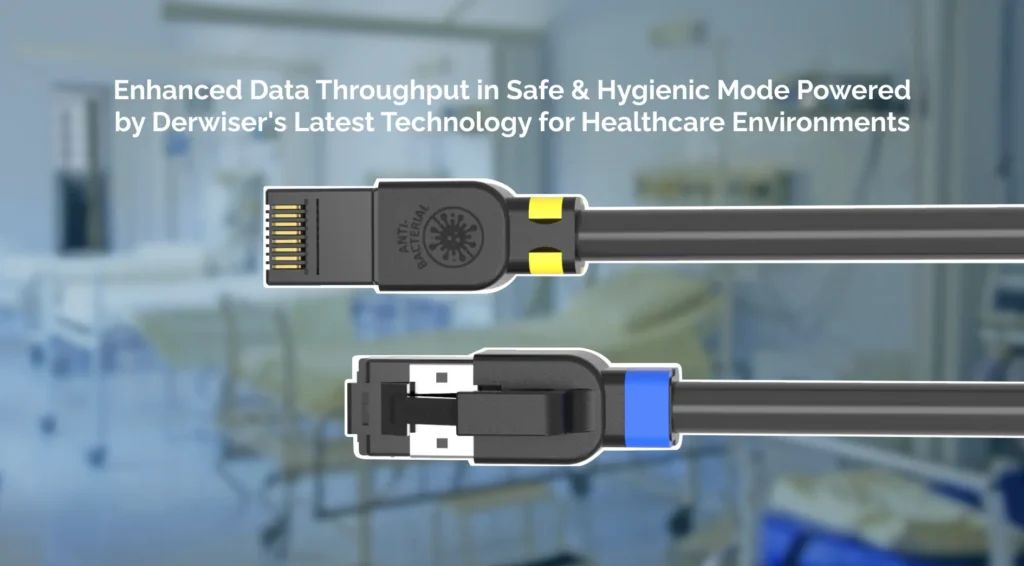It’s a widely known fact that Structured Cabling Solutions are the backbone of every ICT connection. Each and every global standard organization is focused highly on high-speed cabling, cable topology, distance limitation, pathway systems and various other focused approaches like EE (Entrance Facility), ER (Equipment Rooms) etcetera.
However, when it comes to health care facility networking, considering various additional clinical & nonclinical / pharmaceutical applications a special standard was developed (ANSI/TIA-1179-B: Healthcare Facility Telecommunications Infrastructure Standard) by the TIA TR‑42.1 Premises Telecommunications Infrastructure Subcommittee and published in June 2023.
Customer premises, LAN cabling system is one of such components which traverse pathway system and creates the opportunity to have different facilities cabling in single pathway, therefore we at DERWISER, always tries to enhance our capabilities to understand the facility requirements including various factors like fire & safety, Anti-bacterial /hygienic cabling solutions in our offerings which contributes high-end performance and value far beyond its cost.
Objective
An organized way of laying cables (copper/fiber) and installing components (copper/fiber), following certain guidelines/standards (ANSI-EIA/TIA or ISO/IEC), thereby extending a desired performance. The objective is to transport data on the “Physical Media” with minimal loss/change across the network.
In healthcare environments, the practical definition is the complete collective configuration of cabling and associated hardware at any healthcare site that has been installed to provide computer network and telecommunication infrastructure and designed to support a wide range of software protocols, applications, and compatible equipment.
Importance
- Hospitals, treatment centers, and clinics demand increased regulatory compliance and a huge volume of data generated by advancements in medical technology.
- Technological advances have empowered healthcare facilities to automate many administrative and clinical processes, achieving higher levels of efficiency and productivity. This ensures patient privacy, security, and quality care.
- High-performance, IP-based Ethernet networks are becoming the industry standard.
- Although reliable and efficient networks are critical in healthcare facilities, the infrastructure requirements must take a back seat to clinical operations. However, they must do so in a predictable, planned, and consistent way.
Services & Applications run on ITS in Healthcare Infrastructures
| Structured Cabling can Power & Connect | Diagnostic Equipment Access Control Patient Information Systems Telemedicine Emergency Intercom & Call System Security Cameras & Alarms Visitor Wi-Fi Access Pharmaceuticals & Inventory Management |
| Environmental Control Systems | HVAC, Power Monitoring |
| Hospital Security Systems | CCTV, Security Alerts, and Surveillance |
| Fire and Life Safety Systems | Alarms, Sprinkler Systems, The Master Clock |
| Internal Communications Networks | Nursing Stations, Intercom Systems, Call Systems, Interactive and On-demand Patient TV |
| Patient Information Systems | Admissions Procedures, Coordination-Of-Care Databases, Diagnostic Testing and Results, Blood Data, and Medications, Food Services |
| Clinical Equipment Monitoring, Control | Heart Monitors, Laboratory Information Systems, Blood Refrigerators, Cart-Based Equipment. |
| Wireless and Mobile Communications | Mobile Computers and Pdas at the Patient Point of Care, RFID (Radio Frequency Identification) Systems |
| Telemedicine | Remote Consultations, Digital Image Transfer of X-rays, and Diagnostic Imaging Test Results |
| VoIP (Voice over Internet Protocol) | Capable Devices |
Building Backbone – Basic Design – Healthcare
Redundant & Concurrently Maintainable in Healthcare LAN Architecture.
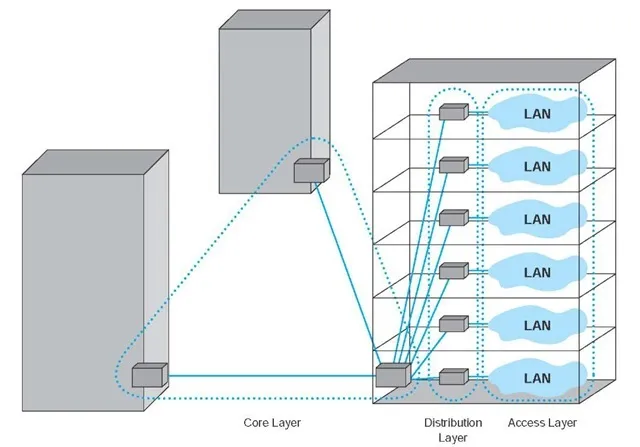
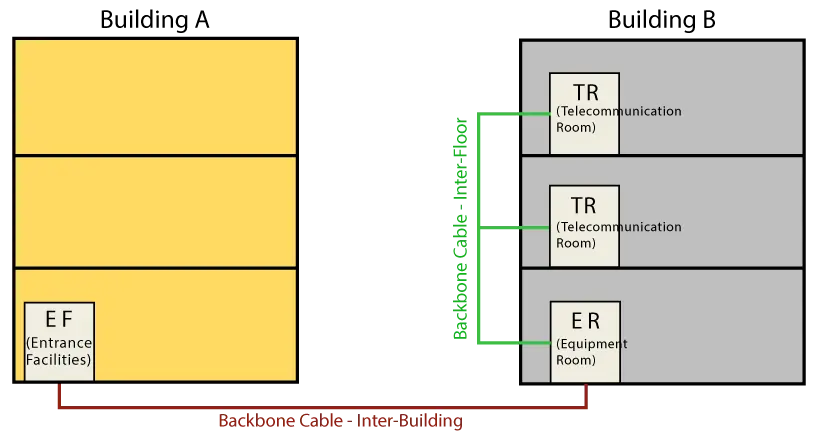
Media Type
One of the first choices faced when planning or developing a structured cabling system is the type of media to be used.
ANSI/TIA/EIA 568 recognizes these different media:
Copper Media
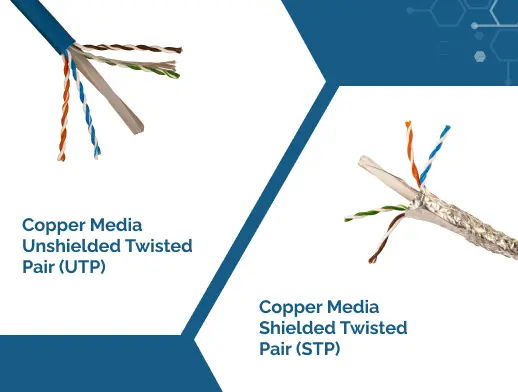
Fiber Media
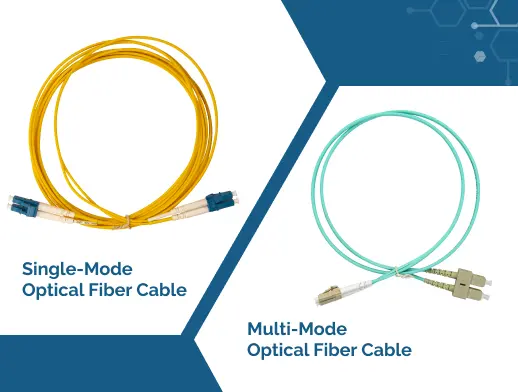
Why Choose Cat 6A Cabling Systems?
SPEED – CAT 6A cables support data rates of up to 10 Gbps, combined with a bandwidth of 500MHz. This cable can transmit data at higher speeds over greater distances.
POWER – The last mile connections in healthcare facilities are power-hungry. Everything from smart lighting to security cameras needs power. CAT 6A cables can handle more power demands than other cables without slowing down or hindering performance.
CAT 6A cables are made to last, with manufacturer warranties of up to 30 years.
Unique Products for Healthcare
Shielded Cabling Solutions – Interference generated by cabling may affect the performance of diagnostic machines and gadgets, and vice versa, for which accuracy is critical. Shielded cabling solutions restrict EMI and deliver the desired performance for both.

- Fiber Optic Solutions: Fiber optic cables are completely immune to electromagnetic interference and radio frequency interferences, thus delivering the desired performance. Its parameters supporting higher lengths, higher bandwidths, and high-density solutions give added advantages to design big campuses, extremely high node densities, and very high-speed networks.

- Infection Spread Prevention – The Antibacterial/Antimicrobial ingredients are added onto the SCS connective hardware to make the healthcare environment safer and more hygienic. Cables, Patch Cords, Face plates, and connectors are recommended to be used with an Antibacterial/Antimicrobial property.
One such product is the Antibacterial/Antimicrobial Shielded LSZH Patch Cords

- Patch Cords are the most handled structured cabling product due to moves, additions, or changes in any network.
- In healthcare environments with too much interference, shielded patch cords are required.
- Antibacterial/Antimicrobial Shielded Patch Cords reduce the risk of spreading bacteria and germs.
- The antibacterial ingredients were added onto the RJ45 connector and the LAN cable jacket to meet the respective ISO testing standards.
- The long-lasting antibacterial effect reduces the risk of bacterial transmission.
- This improves the safety of the cabling infrastructure environment.
Summary
Technological advances have empowered healthcare facilities to automate many administrative and clinical processes, achieving higher levels of efficiency and productivity. This ensures patient privacy, security, and quality care.
Hospital management is under constant pressure to control operational costs while increasing patient safety, care, and service levels.
The use of shielded copper solutions for indoor environments, fiber solutions for indoor and outdoor environments, and specially recommended hygiene-supporting products help the healthcare industry to have robust, high-performing, and future-ready scalable networks.
